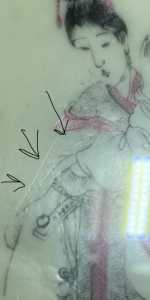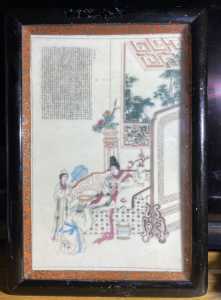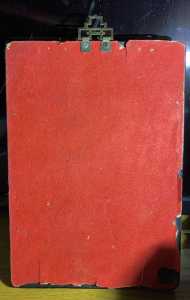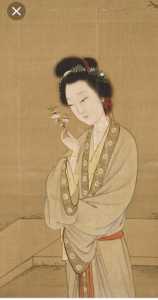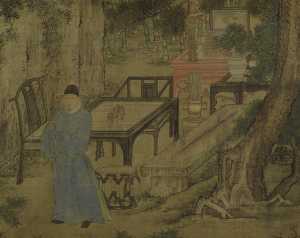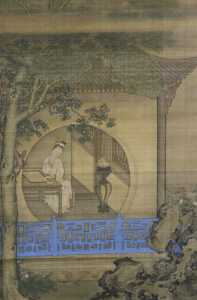The Chinese and Asian Art Forum. For Fans, Collectors and Dealers.
 Basic Rules For the BidAmount Asian Art Forum: Talk about whatever you want. You can even discuss and offer things that are for sale if they are authentic. Maximum image file size per post is 2 MB. Images of 700pxl x 700pxl are optimal if saved at a medium resolution. Be respectful of others and enjoy yourself. Click the YouTube link for a brief tutorial on using the forum. You can also EMBED Videos by cutting and pasting from You-Tube, Vimeo etc.
Basic Rules For the BidAmount Asian Art Forum: Talk about whatever you want. You can even discuss and offer things that are for sale if they are authentic. Maximum image file size per post is 2 MB. Images of 700pxl x 700pxl are optimal if saved at a medium resolution. Be respectful of others and enjoy yourself. Click the YouTube link for a brief tutorial on using the forum. You can also EMBED Videos by cutting and pasting from You-Tube, Vimeo etc.
NOTE: To post an item or add a new post, click open the category title from the FORUM LIST, and CLICK the Blue ADD TOPIC button.
@greeno107 it’s funny you mention the bright light we looked all over the house for a daylight bulb and only had warm so I picking one up tonight just for this reason I will post new lighted pictures tonight.
Qianjiang ceramics painting is a term used to describe a type of over glaze enamelled ware which was very popular during the Late Qing/Early Republican Period. The term Qianjiang cai (enamels) or Qianjiang porcelain was only coined in the 1950s. Prior to that, annals or commentaries in late Qing and Republican period did not classify it as a new distinctive type of over-glaze enamel decorative technique on porcelain.
https://gotheborg.com/glossary/qianjiang.shtml
Qianjiang means literally "light umber" and is a Yuan Dynasty literati painting on paper style where the landscapes are outlined with ink and complemented by strokes of pale umber to designate the lit areas of the landscape. Qianjiang enamels was applied directly on the white glazed porcelain surface, giving the decoration the appearance of watercolor painting on silk or paper.
The decorations are pale in coloration and delicate in feeling, in sharp contrast to the richly almost gaudily painted porcelain of the time.
Qianjiang painting on porcelain flourished in the latter half of the 19th century up to the early Republic Period around 1910. Objects decorated in this style includes brush pots, tea wares, bowls, hat stands etc where a significant proportions being flat porcelain plaques made to be fitted into screens or furniture.
https://www.bonhams.com/auctions/21773/lot/6385/
@short-dong thanks I thought it was a style of artwork now I know it’s a process thanks my mistake in classification.
Here is a picture we’re the paint/ink has been loss and the carved porcelain is colorless. I’m usually a daylight spotlight. They measure 9x6 inches.
Birgit and Julia have already alluded to the things that most struck me when I saw the pictures - the crisp, Western perspective and the Japanese look of the faces. The lady playing the sheng, with her aquiline nose, could not look more Japanese.
Also, the orange brocade lining looks distinctly Japanese.
Brian, can you please identify the article you're referring to that discusses this kind of porcelain painting?
Regards,
John
@jjytlee here is the link you guys have requested thanks.
http://www.chinatoday.com.cn/ctenglish/2018/cs/201904/t20190425_800165881.html
We all have to keep in mind that when carving something the artwork cannot be duplicated as if it was painted your asking for details that simply can’t exist. On a 2 dimensional objection.
Brian, looks like you've really started something. I googled a bit, and there actually exists a website, www.keciyishu.com, devoted to the subject of carved porcelain, keci 刻瓷. There appear to be many late Qing examples shown on the site. Another bottomless pit...
Regards,
John
@jjytlee thanks for the link. It’s hard to see the craftsmanship in the photos seeing it in person under a magnifying glass is a different experience. I can actually see the carving and techniques. I look forward to learn more about this style and history I actually plan on keeping these I’m going to get the one plaque restored and new glass.
John I wanted to thank you again for the link you shared it was eye opening for me we have a lot to learn about Chinese art. I am more confident in these carved plaques. I believe now these carving are a depiction of a Ming scrolls the artist might had simply copied scrolls that were viewed at some point the style is unmistakable. After viewing the website I am understanding that we need to stop thinking everything was made one directional. I believe many independent artist created there own styles and no one source can be accepted. Thank you
@lotusblack That's an interesting point about artistic variations, and I think a valid one. The exception could be imperial wares, that were done in more predictable way. But outside of that anomalies certainly must exist. Of course, getting people to accept them is another matter entirely, as we are all aware. Just go to a concert and you will see, everyone wants to hear the songs they already know, nevermind that the songwriter just wrote a new tune that is his best ever. John
@lotusblack Brian, I never heard of carved porcelain, so thank you for the enlightenment!
That said, I think you need to reassess your plaques, and compare to the photos in the article.
The examples in the article show images that resemble brush paintings, wide and narrow strokes with a lot of depth in the rendering.
The article you posted reads:
“Beijing carved porcelain is crafted on the glazed surface of porcelain by utilizing the skills of chiseling, engraving, and carving to present various details of a traditional Chinese painting. Different lines are used as the basis to present the appearance and spirit of the pattern to be carved. The carved images are then colored with Chinese ink or colorful pigments. The clear contrast caused by the difference between the smooth glaze and all the harsh carved tracks give the porcelain new values in the eyes of collectors.”
So, when looking at your plaques, the decoration is purely composed of the same size thin scratches on the surface, and not carved as described in the article.
However, when comparing your plaques to the ivory miniature plaques, the similarity is quite obvious.
Your ‘clear’ photo in ‘good’ light that shows what the plaque is made of…. Come on! You can do better.
Even so…. The photo shows scratching, not carving, so I suspect the plaques might be Bakelight (plastic) if not ivory.
They are fine works of miniature calligraphy in my opinion.
“I believe now these carving are a depiction of a Ming scrolls the artist might had simply copied scrolls that were viewed at some point the style is unmistakable.”
Brian, is a quarter pounder from McDonalds the same as prime rib from Ruth Chris?
They both are derived from beef, but can you reasonably compare the two and say that are similar? No.
I like your miniature plaques…I’ve said that from the start. But, you are wandering down the wrong rabbit hole.
Miniature calligraphy plaques were novelties for the tourist tradition because they were small and easy to take home as tourist items.
A few artists elevated the quality to the level of collectible art.
Your plaque with the very long poem could be such an example.
Post clear pics of the calligraphy and let’s figure out the material of the plaque.
I support further research, but not the path you seem to be going with these comparisons to Ming painting masterpieces.
When you have to suck up your pride for the sake of art. I had the plaques looked at today. Tim was spot on etched Bakelite. I was told these would have been bright white but Bakelite turns cream color like ivory. So my dreams of carved porcelain are gone. Thanks everyone for you input. They were hand etched and painted with ink but the method would have not been so complicated. I was told these would have been the early day forgery as the plaques were made to deceive.
Thanks for visiting "The BidAmount Asian Art Forum | Chinese Art"
If you sell on eBay, or have a shop feel free to post images and descriptions and links.
Check back often for discussion about the latest news in the Chinese art and antique world. Also find out about the latest Asian art auctions at Sotheby's, Christie's, Bonhams and Tajans.
Auction results for: fine porcelain, ceramics, bronze, jade, textiles and scholar's objects. As well as Japanese, Thai, Vietnamese and other Asian cultures.
Thank you,
Peter Combs
Topics and categories on The BidAmount Asian Art Forum | Chinese Art
Kangxi vases, Kangxi dishes and chargers, Kangxi ritual pieces, Kangxi scholar's objects, Qianlong famille rose, Qianlong enamels, Qianlong period paintings, Qianlong Emporer's court, Fine porcelain of the Yongzheng period. Chinese imperial art, Ming porcelain including Jiajing, Wanli, Xuande, Chenghua as well as Ming jades and bronzes.
The BidAmount Asian Art Forum | Chinese Art
A free Asian art discussion board and Asian art message board for dealers and collectors of art and antiques from China, Japan, Korea, Thailand, Cambodia, Vietnam and the rest of Asia. Linked to all of the BidAmount Asian art reference areas, with videos from plcombs Asian Art and Bidamount on YouTube. Sign up also for the weekly BidAmount newsletter and catalogs of active eBay listing of Chinese porcelain, bronze, jades, robes, and paintings.
The art of calligraphy - and for the ancient Chinese it certainly was an art - aimed to demonstrate superior control and skill using brush and ink. Calligraphy established itself as one of the major Chinese art forms during the Han dynasty (206 BCE - 220 CE), and for two millennia after, all educated men were expected to be proficient at it.
The Museum’s collections of Asian art span nearly five millennia and encompass the cultures of China, the Himalayas, India, Japan, Korea, and Southeast Asia. In 2007, the Museum launched an initiative to create dedicated galleries for the collection, beginning with a gallery for the arts of Korea ...
Chinese art is full of symbolism, in that artists typically seek to depict some aspect of a totality of which they are intuitively aware.
China Online Museum is the finest online museum of Chinese art. It features Chinese calligraphy, painting, ceramics, bronzes, carving, and other artworks.
Chinese Ceramics & Works of Art. Overview Upcoming auctions Contacts Auction results ... Christie’s sales of Chinese ceramics and works of art showcase centuries of Chinese history. Held throughout the year in London, New York, Paris and Hong Kong, they attract a wide audience of collectors and connoisseurs vying for pieces as diverse as ...
Explore Asian Art Week. Contact the Specialist Department. Chinese Paintings ... Senior Specialist, Head of Sale. [email protected]. Tel:+1 212 641 5760. Bid in-person or online for the upcoming auction:Fine Chinese Paintings on 10 September 2019 at New York. Bid in-person or online for the upcoming auction:Fine Chinese Paintings on 10 ...
Discover an abundance of must-see art from all corners of a vast continent at Christie’s NY Asian Art Week. From contemporary classical and Chinese paintings to works with exemplary provenance from the Art Institute of Chicago, our Rockefeller Paza galleries will be full of ancient treasures and contemporary masterworks in a salute to the vibrant arts of Asia.
Sold to benefit The Art Institute of Chicago’s Asian Art Acquisition Fund, the sale features 84 lots with a focus on Ming and Qing porcelains, and offers a rare insight into the taste for collecting Chinese ceramics and works of art in the Midwest from the end of the 19th century through the 1980s. Highlights include two Wanli wucai garlic-head vases, a Qianlong mark and period, blue and ...
Specialist, Chinese Paintings, Christie's London Dr Malcolm McNeill is a Specialist in Chinese Paintings at Christie’s, based in London. He previously worked as an assistant curator of the Chinese collections and the Victoria and Albert Museum in London, as a researcher at the British Museum, and as a translator and tour guide at the National Palace Museum in Taipei.
The Christie's Education 2020 Conference: The Chinese Art Market 18 Jun 2019 Christie’s Education is delighted to announce our first international academic conference in Asia which will take place in Hong Kong from 26-27 November 2020 at the Hong Kong Convention and Exhibition Centre and will run in parallel with Christie’s Hong Kong Autumn Auctions.
The summer Chinese Art sale in Hong Kong will feature works of art from several private collections, including Qing porcelains and textile from the collection of the legendary Chinese art dealer A. W. Bahr (1877–1959), fine gilt bronze Buddhist sculptures from an old Hong Kong collection, an East Asian collection of Qing dynasty wine cups and jades, and a Japanese collection of Song ceramics ...
Sotheby's Chinese Works of Art Department holds two auctions each year in London, New York, Hong Kong and Paris.
Chinese Art - View Auction details, bid, buy and collect the various artworks at Sothebys Art Auction House.
With more than 340 Chinese works of art dating from the Neolithic to the Republic periods, highlights of this sale include a selection of Qing Imperial monochromes from the collection of Arnold and Blema Steinberg, early ceramics from the Art Institute of Chicago and Chinese porcelain and works of art from the collection of Henry Arnhold.
Results: Sotheby's Asia Week achieved $52.4 million in six strong auctions, exceeding pre-sale estimates. With 76.5% of lots sold and 60.3% of lots surpassing high estimates, the Asian art sales at Sotheby's indicate continued collector interest in the finest works of art from China, India and and the Himalayas.
Today's sale of Important Chinese Art will proceed as planned with sessions at 10 AM and 2 PM EDT. Sotheby's will be monitoring the weather conditions throughout the day and will be available to coordinate alternative bidding options should conditions make it difficult for clients to attend the auction in person.
Bonhams Chinese Art department is renowned for offering the finest works of art representing the richness and breadth of China's artistic heritage, particularly Imperial porcelain, white and spinach green jades, cloisonné and Buddhist art. Specialised international auctions are held globally, including London, Hong Kong and San Francisco.
Bonhams : Chinese Works of Art We use cookies to remember choices you make on functionality and personal features to enhance your experience to our site. By continuing to use our site you consent to the use of cookies. Please refer to our privacy and cookie policies for more information.
Bonhams Fine Art Auctioneers & Valuers: auctioneers of art, pictures, collectables and motor cars. We use cookies to remember choices you make on functionality and personal features to enhance your experience to our site. By continuing to use our site you consent to the use of cookies. ... Chinese Art (US) General enquiries
Bonhams : Fine Chinese Art We use cookies to remember choices you make on functionality and personal features to enhance your experience to our site. By continuing to use our site you consent to the use of cookies. Please refer to our privacy and cookie policies for more information.
Bonhams Fine Art Auctioneers & Valuers: auctioneers of art, pictures, collectables and motor cars Bonhams : Asian Art We use cookies to remember choices you make on functionality and personal features to enhance your experience to our site.
Bonhams are international auctioneers of fine Chinese and Japanese art. We specialise in rare Imperial and Export Chinese ceramics and works of art, as well as Japanese ceramics, fine and decorative works of art from the Neolithic Period to the 20th century. View on map
Bonhams Fine Art Auctioneers & Valuers: auctioneers of art, pictures, collectables and motor cars. We use cookies to remember choices you make on functionality and personal features to enhance your experience to our site. By continuing to use our site you consent to the use of cookies. ... Asian Art Bonhams. Work. 22 Queen St.
